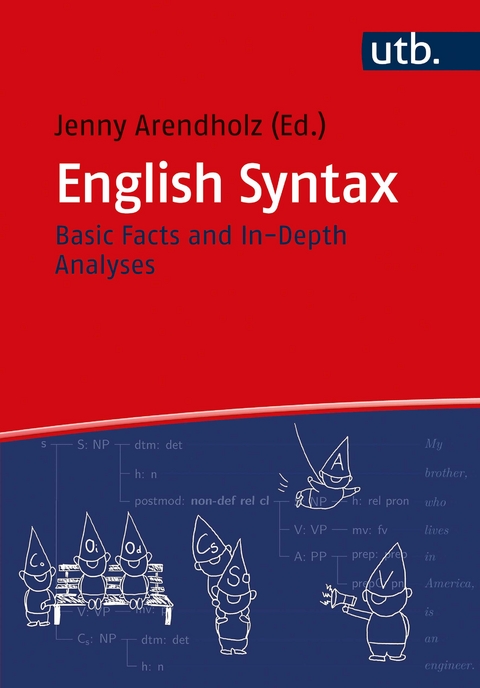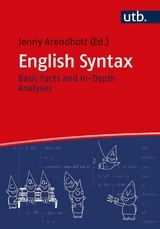English Syntax
UTB (Verlag)
978-3-8252-5655-5 (ISBN)
Dr. Jenny Arendholz lehrt synchrone Sprachwissenschaft und Sprachpraxis des Englischen an der LMU München.
Preface
List of abbreviations (alphabetical order)
List of abbreviations (structural order)
1 Basic Introduction and Syntactic Functions – Jenny Arendholz
1.1 Some Structural Facts and Layout Conventions
1.2 The Seven Syntactic Functions
1.3 Tricky Business: Oi vs. Oprep
2 The Internal Structure of Phrases – Jenny Arendholz
2.1 Characteristic Features of Phrases
2.2 The Noun Phrase (NP)
2.3 The Adjective Phrase (AdjP) and the Adverb Phrase (AdvP)
2.4 The Verb Phrase (VP)
2.5 The Prepositional Phrase (PP)
2.6 Tricky Business
2.6.1 Nouns in the Premodifier Slot of NPs
2.6.2 Embedding
2.6.3 Complementation
2.6.4 Complex Determinatives
3 Word Classes – Michaela Pitsch
3.1 Nouns
3.2 Adjectives and Adverbs
3.3 Adjectives vs. Adverbs
3.4 Pronouns and Determiners
3.5 Pronouns vs. Determiners
3.6 Prepositions and Conjunctions
3.7 Prepositions vs. Subordinating Conjunctions
3.8 Adverbs vs. Subordinating Conjunctions
3.9 Numerals
3.10 Words of Unique Function
3.11 Tricky Business
3.11.1 Some as an Adverb
3.11.2 Change of Word Class
4 The Verb – Sandra Neigefind
4.1 Distinction According to Word Class
4.1.1 Full Verbs
4.1.2 Modal Auxiliary Verbs
4.1.3 A Special Case of Modals: Catenative Verb Constructions
4.1.4 Primary Verbs
4.2 Copular Verbs
4.3 Multi-Word Verbs
4.3.1 Phrasal Verbs
4.3.2 Prepositional Verbs
4.3.3 Phrasal-Prepositional Verbs
4.3.4 Detection Rules
5 An Introduction to Complex Sentences – Hannah Jahner & Jenny Arendholz
5.1 Clauses vs. Phrases
5.2 Sentences and Clause Combinations
5.3 Subordinate Clauses
5.3.1 Nominal Clauses
5.3.2 Adverbial Clauses
5.4 Embedded Clauses
5.5 Summary: Syntactic Functions of Dependent Clauses
6 Finite Clauses – Jenny Arendholz & Michaela Pitsch
6.1 Adverbial Clauses
6.2 Wh-Clauses
6.3 That-Clauses
6.4 Attributive Relative Clauses
6.5 Nominal Relative Clauses
6.6 Sentential Relative Clauses
6.7 Comparative Clauses
6.8 Tricky Business: Is that Still a Problem?
7 Non-Finite Clauses and Verbless Clauses – Lioba Arnoldi
7.1 -ing-Participle Clauses
7.1.1 Subordinate -ing-Participle Clauses
7.1.2 Attributive -ing-Participle Clauses
7.2 -ed-Participle Clauses
7.2.1 Subordinate -ed-Participle Clauses
7.2.2 Attributive -ed-Participle Clauses
7.3 to-Infinitive Clauses
7.3.1 Subordinate to-Infinitive Clauses
7.3.2 Attributive to-Infinitive Clauses
7.4 Bare Infinitive Clauses
7.5 Verbless Clauses
7.6 Tricky Business
7.6.1 Catenative Verbs and Non-Finite Forms
7.6.2 Gradience in Non-Finite Clauses
8 Appositions – Franziska Kirchhoff
8.1 Definition and Terminology
8.2 Different Forms of Apposition
8.2.1 Phrasal Apposition
8.2.2 Clausal Apposition
8.3 Indicators of Apposition
8.4 Tricky Business
8.4.1 The Appositive of-Phrase
8.4.2 Distinguishing Apposition from Coordination
9 Coordination – Jenny Arendholz
9.1 Terminology and Basic Structures
9.2 Coordinators
9.3 Types of Coordination
9.4 The Analysis of Coordination
9.4.1 The Ellipsis Strategy
9.4.2 The Conjoint Strategy
9.4.3 The Shift Strategy
9.4.4 Detection Rules
10 Means of Emphasis and Other Deviating Sentence Patterns – Jenny Arendholz
10.1 Theme and Rheme
10.2 Fronting and Inversion
10.3 Cleft Sentences Proper and Pseudo-Cleft Sentences
10.4 Extraposition of Clausal Subjects and Objects
10.5 Existential Constructions
11 Practice Makes Perfect – Britta van den Berg & Jenny Arendholz
11.1 Easy Sentences
11.2 Moderate Sentences
11.4 Difficult Sentences
References
Primary Sources
Secondary Sources
Secondary Online Sources
Index
| Erscheinungsdatum | 28.01.2022 |
|---|---|
| Verlagsort | Stuttgart |
| Sprache | englisch |
| Maße | 150 x 215 mm |
| Gewicht | 525 g |
| Themenwelt | Geisteswissenschaften ► Sprach- / Literaturwissenschaft ► Anglistik / Amerikanistik |
| Geisteswissenschaften ► Sprach- / Literaturwissenschaft ► Sprachwissenschaft | |
| Schlagworte | Adjective • Adjektive • Adverb • Adverbial Clauses • Einführung in die Syntax • Englisch • Englische Grammatik • Englischunterricht • Englisch unterrichten • English • Examensvorbereitung • Examensvorbereitung / Übungsaufgaben • Komparatistik • Konstituent • Konstituentengrammatik • Lehrbuch • Nomen • Nominal Clauses • preposition • pronouns • Satzaufbau im Englischen • Satzbau • Studium Anglistik • Syntax • Syntaxanalyse • Syntaxanalyse, • Übungsaufgaben • Übungsaufgaben englische Grammatik • Verben • Verbs |
| ISBN-10 | 3-8252-5655-3 / 3825256553 |
| ISBN-13 | 978-3-8252-5655-5 / 9783825256555 |
| Zustand | Neuware |
| Informationen gemäß Produktsicherheitsverordnung (GPSR) | |
| Haben Sie eine Frage zum Produkt? |
aus dem Bereich




